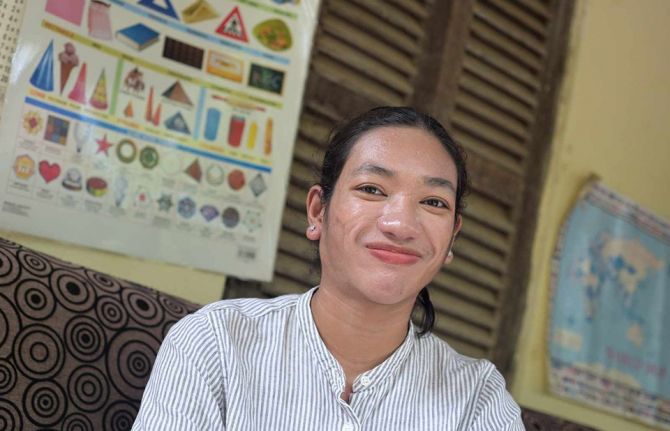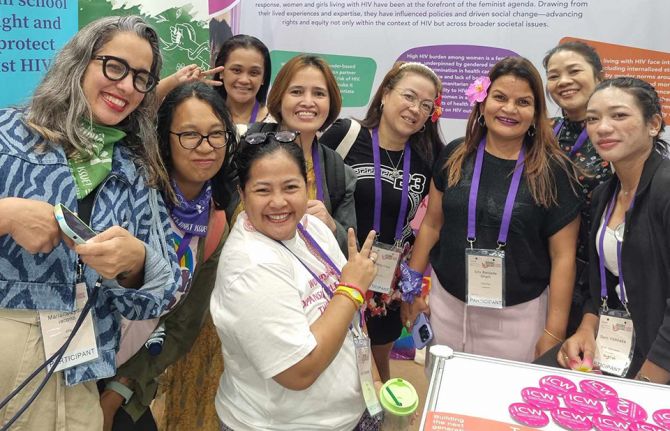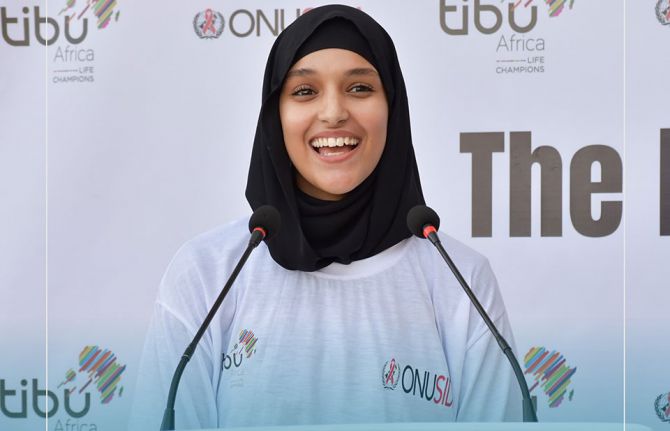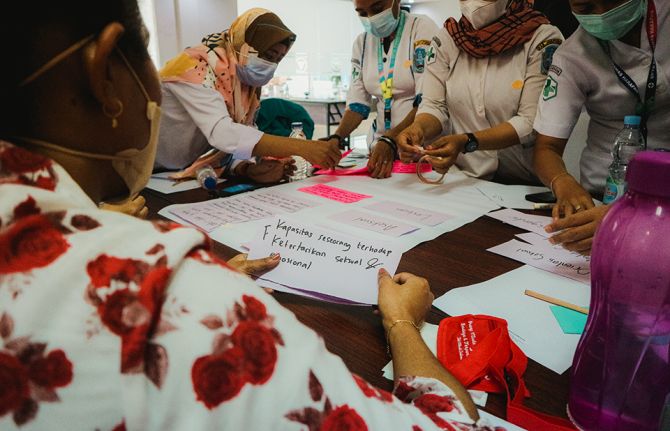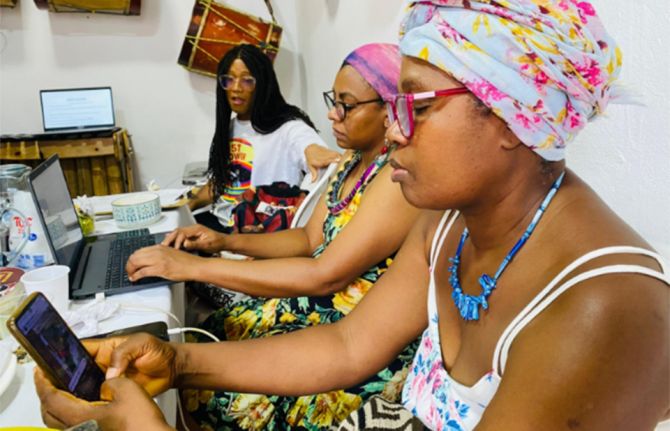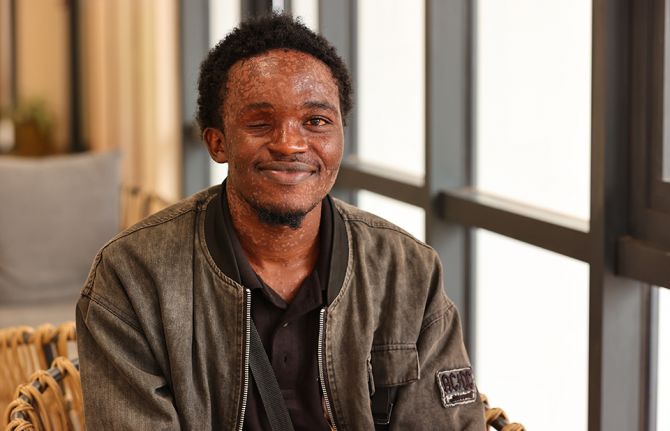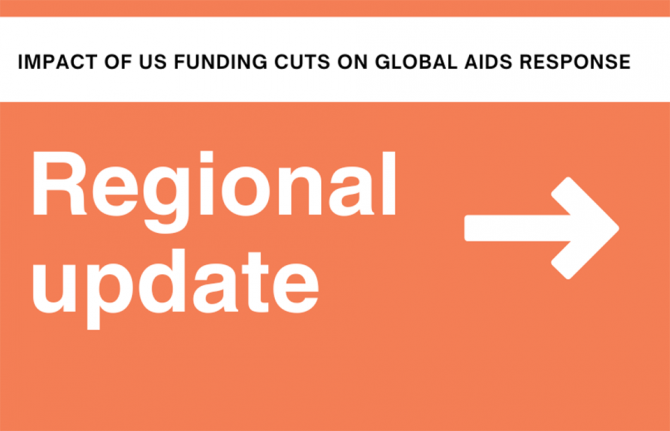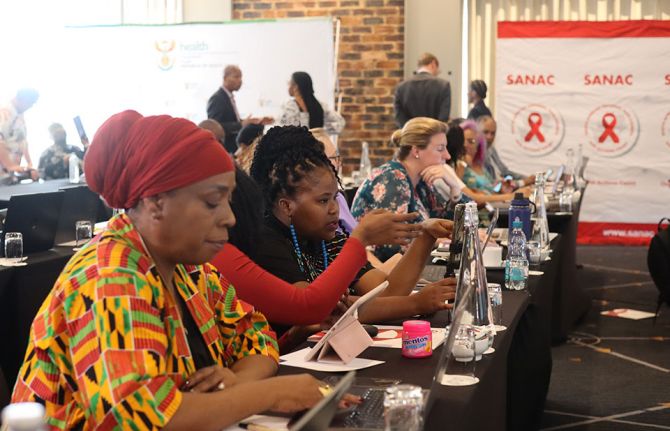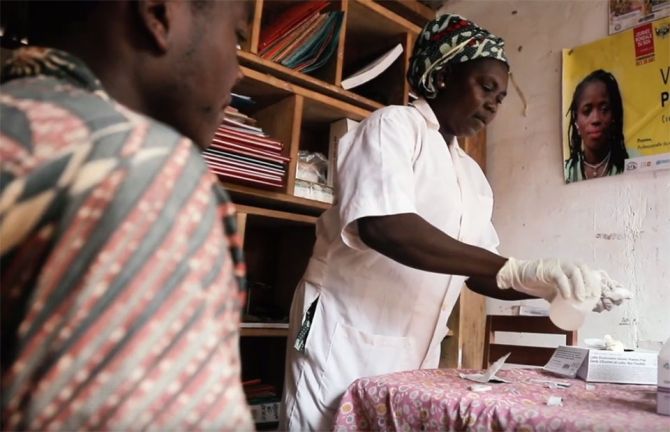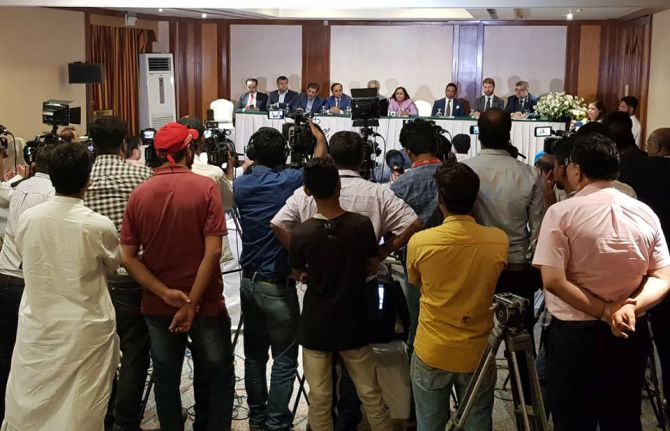
Feature Story
Faith leaders discuss ending stigma at prayer breakfast meeting
17 June 2011
17 June 2011 17 June 2011
Bishop Yvette Flunder addresses the inter-faith prayer breakfast held at Ford Foundation in New York City on 10 June.
Credit: Barry Mason/EAA
On the closing day of the United Nations General Assembly High Level Meeting on AIDS, faith-leaders came together with people living with HIV, representatives from key populations at higher risk of infection and other partners in the AIDS response to discuss ways to end stigma and to build strong collaborative partnerships for future action at country level.
The inter-faith prayer breakfast was co-organized by the Ecumenical Advocacy Alliance (EAA), UNAIDS, and UNFPA in collaboration with other religious organizations and was hosted by the Ford Foundation.
Compassion to end stigma
A wide range of different faith traditions participated in the prayer breakfast meeting. Imam Abdul-Malik Ali, from New Jersey, prayed for all to accept the challenges posed by HIV and the need to overcome stigma. Rev T.K. Nakagaki, Pastor of the Buddhist Church in America, reminded participants of the importance of respect for life, of remembering lives lost due to AIDS and of our interdependence. Rabbi J. Rolando Matalon originally from Buenos Aries, offered a prayer for people living with HIV who suffer from stigma and discrimination.
The panellists then presented their thoughts on how to strengthen and build cross sectoral partnerships in the HIV response in order to ensure that universal access becomes a reality for all by 2015.
His Excellency the President of Fiji Mr Ratu Epeli Nailatikau said he was reminded of the Bible teachings, “which point us in the direction of searching out the one individual who is marginalized and reaching out to them with compassion.”
It is time to build a bridge between key affected populations and world religious leaders to make sure no one is left behind in the next steps that we all are going to take
Mr Pablo Torres Aguilera, youth advocate from Mexico
Her Excellency Mrs Callista Mutharika, First Lady of the Republic of Malawi; highlighted the key role of faith based organizations in providing both HIV health care and home-based care services in Malawi.
Faith leaders play an important in the AIDS response as religious institutions provide upwards of 30% of health care and education services across Africa where the almost 70% of new HIV infections occurred in 2009. Voluntary care workers, many of whom are faith-based, make a significant contribution to human resources in countries on the African continent which is home to around 22.5 million people living with HIV.
Dr Asha-Rose Migiro, Deputy Secretary-General of the United Nations, reminded the audience of faith leaders and others that those from religious institutions can be among the most effective advocates against stigma. "You are natural activists who can change attitudes."
Bishop Yvette Flunder from the USA spoke on how "our healing must be untied from judgement and tied to justice." This statement became the recurring theme of the breakfast. Building on her words, Mr Pablo Torres Aguilera, a 25-year-old youth advocate from Mexico, issued a strong call for action: “It is time to build a bridge between key affected populations and world religious leaders to make sure no one is left behind in the next steps that we all are going to take,” he said.
This was followed by interactive table discussions among participants in which there was consensus on the importance of responses based on compassion and care as powerful methods of eliminating stigma and discrimination towards people living with HIV.

(From left) UNAIDS Executive Director Mr Michel Sidibé; His Excellency the President of Fiji Mr Ratu Epeli Nailatikau; UNAIDS Deputy Executive Director, Management and External Relations Ms Jan Beagle.
Credit: UNAIDS
Echoing Bishop Flunder's words, participants called for HIV responses that are offered in a way that gives dignity to the people who are most marginalized in society. Participants agreed that the specific naming of the key affected populations is important to give someone dignity and respect—be it men who have sex with men, sex workers, transgender people, people who use drugs or others who face marginalization, stigma and discrimination.
Closing the table discussions co-moderator Bishop Emeritus of Oslo Rev Gunnar Stålsett thanked Mr Torres Aguilera for his remarks, and said: "Thank you for being specific, sometimes we do not dare to mention vulnerable groups by name, you have done that, you have broken the barrier." Co-moderator Rabbi Julie Schonfeld said: "We were blessed with the opportunity to have people of so many faith traditions engaged in dialogue today, with our shared desire to bring HIV deaths to zero"
The breakfast closed with three prayers. Mr Homi D. Gandhi (Zoroastrian Association) offered a prayer for the whole harmony of human kind. Swami Pragyapad from India prayed for protection, nourishment, strength, and that we would not oppose each other. In the closing prayer, the Rev. Leonid Kishkovsky, moderator of Religions for Peace, urged all to "move from words of comfort to courageous action."
Also present at the inter-faith event were Rabbi Julie Schonfeld, Rabbi, Executive Vice President of the Rabbinical Assembly, New York; and Imam Umer Ahmed Ilyasi, President and Chief Imam of the All India Organization of Imams of Mosques, UNAIDS Executive Director Mr Michel Sidibé, Dr Purnima Mane, Deputy Executive Director of UNFPA and Mr Peter Prove, Executive Director of the Ecumenical Advocacy Alliance.
External links
Related
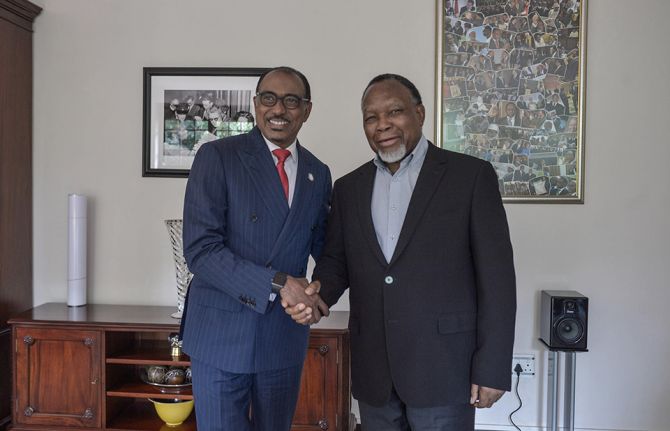 Keeping up the momentum in the global AIDS response
Keeping up the momentum in the global AIDS response

24 April 2019
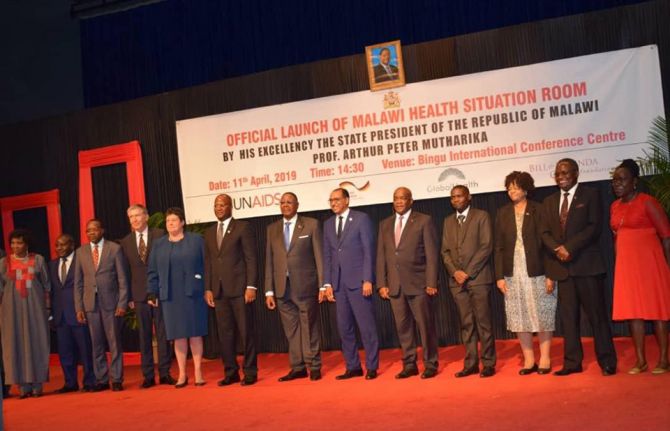 Malawi launches its health situation room
Malawi launches its health situation room

12 April 2019
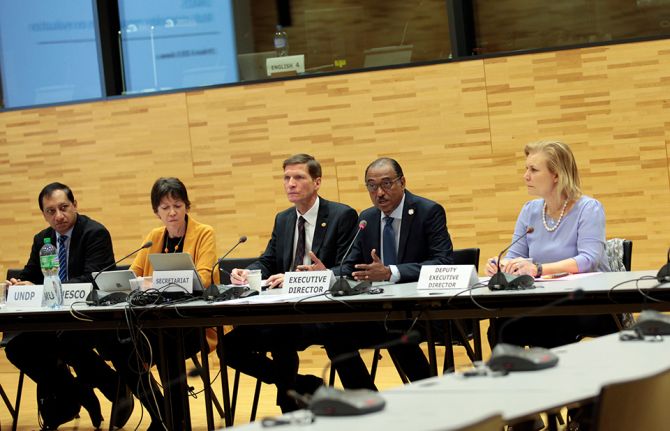 Learning lessons on evaluation
Learning lessons on evaluation

02 April 2019

Feature Story
Call for leaders to champion the needs of women and girls in HIV policy and programming
10 June 2011
10 June 2011 10 June 2011.jpg)
Thematic panel discussion, “Women, Girls, and HIV”, which focuses on the disproportionate burden of HIV that is carried by women and girls around the world. (Left to right): Stephanie Nolan, journalist at the “Globe and Mail”; Hanno Pevkur, Minister of Social Affairs for Estonia; and Dr Aaron Motsoaledi, Minister of Health for the Republic of South Africa. UN Headquarters in New York, 9 June 2011
Credit: UN Photo/Eskinder Debebe
Women, girls and HIV was the theme of a high level panel which was held at the United Nations on Thursday 9 June. The event, which forms part of the UN General Assembly High Level Meeting on AIDS, was chaired by Hanno Pevkur, Minister of Social Affairs, Estonia.
The interactive discussion was moderated by Stephanie Nolen and the high level panel included Dr Aaron Motsoaledi, Minister of Health, Republic of South Africa; Dr Babatunde Osotimehin, Executive Director of UNFPA, represented the United Nations; and Siphiwe Hlophe, the co-founder of the non-governmental organization Swaziland for Positive Living.
“In 30 years of dealing with HIV,” explained Mr Pevkur, “we have learned that it is as much a social as a medical problem; and the lack of quality of sexual reproductive health and rights services, violence, harmful cultural practices, are fuelling the epidemic.”
We will not attain a sustainable response if we do not invest in women with education and economic empowerment
Siphiwe Hlophe, the co-founder of the non-governmental organization Swaziland for Positive Living
To explore the issue, the panellists and speakers from the floor responded to a series of questions and identified strategies that will help the HIV response to spark social transformation for women and girls to secure their human rights and protect themselves against HIV. They discussed ways to ensure that the specific needs and vulnerabilities of women and girls are adequately addressed in the response to HIV.
Unequal opportunities
In many societies, women face barriers in accessing HIV prevention, treatment, care and support services due to limited decision-making power, lack of control over financial resources, restricted mobility and unequal care responsibilities. Lack of education is another major barrier; around two-thirds of the world’s 796 million illiterate adults are women.
“We will not attain a sustainable response if we do not invest in women with education and economic empowerment,” said Ms Hlophe who highlighted need to engage communities including at the rural level so that all women are empowered. There was consensus that comprehensive sexuality education, which includes HIV education, is a key component of effective evidence-informed HIV prevention. Such education should be made available in a non judgemental, youth-friendly way, to adolescents and young people in and out of schools, and must include human rights and gender equality.
Challenge violence against women
One of the event findings was that stopping AIDS requires acting to stop violence against women at every level. “Violence against women is both a cause and a consequence of HIV,” said Minister Pevkur. The participants discussed how to better address the linkages between violence against women and girls and HIV as well as the social determinants that increase their vulnerability to HIV infection.
The risk of HIV among women who have experienced violence may be up to three times higher than those who have not. The prevalence of forced first sex among adolescent girls below 15 years ranges between 11% and 45% globally. Laws and policies that prevent and punish violence against women, including harmful traditional norms, and effective implementation, are paramount the speakers concluded.
Ensure access to comprehensive HIV and sexual and reproductive health services
There were calls for political leaders and stakeholders to champion “women- and girl- tailored” approaches in policy and programming. Another recommendation was the need to ensure that women in all their diversity, including adolescent girls and young women, have access to comprehensive HIV and sexual and reproductive health services, free of violence, discrimination, and coercion.
Uphold women’s human rights
It is crucial for governments to commit to fulfil all women’s human rights, including their sexual and reproductive health and rights. There is an urgent need for a clear target which views women in their entirety, across their lifespan, and not solely as mothers.
Invest in women and girls
The discussion also highlighted the need for greater and sustainable investment in the leadership of women and girls, as well as in strengthening women’s rights organizations and networks of women living with HIV, is needed to achieve the meaningful engagement of women and girls in the response to HIV
UN General Assembly High Level Meeting on AIDS
Thirty years into the AIDS epidemic, and 10 years since the landmark UN General Assembly Special Session on HIV/AIDS, the world has come together to review progress and chart the future course of the global AIDS response at the 2011 UN General Assembly High Level Meeting on AIDS from 8–10 June 2011 in New York. Member States are expected to adopt a new Declaration that will reaffirm current commitments and commit to actions to guide and sustain the global AIDS response.
External links
External links
Publications
Publications
- Backgrounder Panel 4: Women, girls and HIV (pdf, 186 Kb)

Feature Story
It’s possible: Making the most of linking sexual and reproductive health and HIV responses
09 June 2011
09 June 2011 09 June 2011
Dr Babatunde Osotimehin.
Credit: UNFPA
Linking sexual and reproductive health and HIV is of critical importance. Worldwide more than 80% of HIV infections are sexually transmitted. In addition, sexual and reproductive ill health and HIV are fueled by similar causes such as poverty, limited access to services, lack of correct information, gender inequality and social marginalization.
On 8 June, during a side event at this week’s General Assembly High Level Meeting on AIDS in New York, the question of how exactly such linkages can be strengthened was explored. The event was sponsored by UNAIDS, the UN Educational, Scientific and Cultural Organization (UNESCO), the UN Population Fund (UNFPA), the World Health Organization (WHO), and the International Planned Parenthood Federation (IPPF).
The highly interactive session looked at the issue through the prism of five key thematic areas: cost-effectiveness and cost savings of linkages; prevention of mother to child transmission though a sexual and reproductive health platform; comprehensive sexuality education for young people; ending gender-based violence; and human rights of people living with HIV.
Making ‘people-sense’
In his opening remarks, Dr Babatunde Osotimehin, UNFPA Executive Director, explained how the integration of sexual and reproductive health and HIV services makes ‘people-sense’. These services include testing for HIV and other sexually transmitted infections, prevention of mother-to-child transmission, support for fertility decisions, and access to condoms, contraception and correct information. He went on to emphasize wider policy and human rights implications.
“Linking sexual and reproductive health and HIV goes beyond integrating health services,” he said. “It demands from us that we fortify the human rights platform–ending stigma, violence and discrimination.”
Human rights and the right to health were said to be at the core of greater integration of services. A broader human rights agenda can also be promoted that goes beyond service delivery and tackles legal reforms, such as those relating to the right to information and freedom from violence, abuse and coercion.
Sharing ideas and experience
The participants shared ideas and experiences of how those working in the fields of HIV and sexual and reproductive health have combined their efforts to make interventions more effective in creative and innovative ways, including strategies to strengthen treatment as a prevention option.
It was stressed that mother- and child-centred care can improve both sexual and reproductive health and HIV outcomes. For many women, pregnancy is the first point of access in the health system and they can benefit from a range of interventions, including HIV prevention and treatment integrated into routine maternal health care; family planning; and preventing and managing sexually transmitted infections and gender-based violence.
The discussion also showed that when comprehensive sexuality education is effectively implemented on a national scale, there is potential for cost saving from averting HIV infections, other STIs and unintended pregnancies.
Participants examined how men can benefit from greater integration. For instance, in countries where voluntary male circumcision is being implemented for HIV prevention, the number of men accessing other sexual and reproductive services, such as prevention of mother-to-child transmission and treatment of STIs, has increased.
The meeting closed with agreement that linking sexual and reproductive health and the HIV response, especially in a climate of austerity, is a gateway to strengthening both the human rights agenda and health systems.
External links
Related

Feature Story
UNAIDS International Goodwill Ambassador HRH Mette-Marit of Norway supports youth event ahead of High Level Meeting on AIDS
07 June 2011
07 June 2011 07 June 2011
An event convened by young people in New York ahead of the UN General Assembly High Level Meeting on AIDS was attended by UNAIDS International Goodwill Ambassador Her Royal Highness (HRH) Crown Princess Mette-Marit. Credit: NORWAY UN
An event convened by young people in New York ahead of the UN General Assembly High Level Meeting on AIDS was attended by UNAIDS International Goodwill Ambassador Her Royal Highness (HRH) Crown Princess Mette-Marit.
The youth summit on 7 June was co-organized by some of the largest youth-led networks working on AIDS including the Global Youth Coalition on HIV/AIDS and Youth R.I.S.E; together with the International Planned Parenthood Federation together with UNAIDS.
Young people are increasingly using condoms, delaying sexual debut and having fewer sexual partners, leading the HIV prevention revolution in many high prevalence countries. In South Africa, for example, the rate of new HIV infections fell by more than 35 % between 2001 and 2009—among women aged 15-24 new HIV infections declined sharply from 5.5% to 2.2% between 2003 and 2005.
Speaking at the event, HRH Mette-Marit said, “Despite the immense progress on scaling up the global AIDS response, great challenges remain. Young people are particularly vulnerable to HIV infection and they must have access to information and services to help them protect themselves against HIV.”
We need to unleash the full power and potential of young people to lead the global AIDS response. We can do that by engaging them as equal and empowered partners
Her Royal Highness Crown Princess Mette-Marit, UNAIDS International Goodwill Ambassador
HRH Mette-Marit is a long-time champion of youth leadership. “We need to unleash the full power and potential of young people to lead the global AIDS response. We can do that by engaging them as equal and empowered partners,” she said.
There are an estimated five million young people living with HIV, and 3 000 become newly infected daily. However, according to the most recent population-based surveys in low- and middle-income countries, only 24% of young women and 36% of young men responded correctly when asked five questions on HIV prevention and misconceptions around HIV transmission.
Building on the momentum generated at two events earlier in 2011—the Global Youth Summit on HIV in Mali in April, and the High Level Commission on HIV Prevention in South Africa in May—the Youth Summit was a forum for young leaders to come together and gain an understanding of the General Assembly High Level Meeting on AIDS and the expected outcome Declaration of Commitment.
An advocacy strategy was developed by the more than 50 youth activists during the pre-youth summit to ensure that issues that are important to the youth networks are adequately covered in the forthcoming High Level Meeting on AIDS.
With this pre-youth summit we want to create a strategy to follow up the resolution to hold our governments accountable so that the commitments that are made here are really going to happen in our communities
Pablo Aguilera, Dance for Life International
“Being here [at the High Level Meeting] is important. Not just talking about wanting to be involved but really being involved,” said Pablo Aguilera, Dance for Life International. “With this pre-youth summit we want to create a strategy to follow up the resolution to hold our governments accountable so that the commitments that are made here are really going to happen in our communities.”
The summit also produced a roadmap of follow-up activities to ensure that political leaders are held accountable to their declaration following the High Level Meeting on AIDS.
UN General Assembly High Level Meeting on AIDS
Thirty years into the AIDS epidemic, and 10 years since the landmark UN General Assembly Special Session on HIV/AIDS, the world has come together to review progress and chart the future course of the global AIDS response at the 2011 UN General Assembly High Level Meeting on AIDS from 8–10 June 2011 in New York. Member States are expected to adopt a new Declaration that will reaffirm current commitments and commit to actions to guide and sustain the global AIDS response.
External Links
External Links
Presse Releases
Related
 “Who will protect our young people?”
“Who will protect our young people?”

02 June 2025

Feature Story
Put girls first, speakers urge governments during Commission on Population and Development event
19 April 2011
19 April 2011 19 April 2011A version of this story was first published at unfpa.org

Dr Babatunde Osotimehin, Executive Director of UNFPA putting girls first during a side event at the 44th Session of the Commission on Population and Development. Credit: Antti Kaartinen/UNFPA
“Investing in adolescent girls benefits everyone, and when they flourish, their families and communities flourish as well. That’s why they are at the heart of our agenda.” This was the message of Dr Babatunde Osotimehin, Executive Director of UNFPA, speaking at the 44th Session of the Commission on Population and Development (CPD).
Dr Osotimehin addressed a side event called Putting Girls First during the CPD, which ran from 11-15 April at UN Headquarters in New York. It was attended by representatives of Member States, non-governmental organizations and experts participating in the CPD from around the world.
UNFPA’s Executive Director underlined the need to promote girls’ rights and gender equality and to prioritize them within national programmes for health, education, livelihoods and security. “Depending on the opportunities or choices girls have during adolescence, they can begin adulthood as empowered and active citizens, or they can be entrenched in poverty, neglected and voiceless,” Dr Osotimehin warned. “We must put girls first today to make a better tomorrow for everyone.”
Investing in adolescent girls benefits everyone, and when they flourish, their families and communities flourish as well.
Dr Babatunde Osotimehin, Executive Director of UNFPA
Another speaker, Dr. Gill Greer, Director-General of the International Planned Parenthood Federation (IPPF), said that “until girls are seen by their families and communities to have the same inherent worth as their brothers we cannot achieve resilient, sustainable social, economic and environmental development.”
She noted that, on a global level, girls still lag behind boys in secondary school attendance, saying that 70% of the 130 million out-of-school young people are girls and highlighted young women’s particular vulnerability to HIV. According to UNAIDS, young women account for more than two-thirds of new infections among young people worldwide.
Dr Greer added, “Today, it is time to put girls first so they can make the decisions that will drive development, and enable them to stand beside their brothers, partners, and husbands to hold up half the sky.”
External links
External links

Feature Story
Empowering young people in Latin America to participate in Global Fund proposals through national mechanisms
07 April 2011
07 April 2011 07 April 2011
Participants in the workshop learn how to engage youth in the development, implementation and monitoring of Global Fund proposals. Panama City, Panama. 2-4 April 2011
Young people working on AIDS issues in Latin America are learning how to engage youth in the development, implementation and monitoring of Global Fund proposals through national mechanisms.
“We want to be able to speak on our own behalf. This workshop will give us tools to advocate at country level to ensure the creation of youth-centred programmes that reflect our needs,” said Ivens Reyner from the Youth Coalition—an international organization of young people committed to promoting adolescent and youth sexual and reproductive rights—and one of the young people responsible for organizing a training.
The event, which took place in Panama City from 2-4 April, is part of a series of regional workshops organized by the Youth Coalition and the Secretariat of the Global Fund to fight AIDS, Tuberculosis and Malaria.
The Global Fund Board of Governors recognized in its meeting in late 2009, the need to include more young men and women in the various processes both at global and national level. In recent months youth representatives from the Africa and Asian Pacific regions have been attending similar workshops in Cape Town and Bangkok respectively.
This workshop will give us tools to advocate at country level to ensure the creation of youth centred programmes that reflect our needs
Ivens Reyner, Youth Coalition member and organizer of the training
The young people who participated in the South Africa and Thailand workshops subsequently joined the Country Coordinating Mechanisms in their countries. They also participated in the proposal development and even become sub-recipients of the Global Fund grants.
“Young people taking ownership and demanding involvement in national programmes and Global Fund processes is core to ensure we reach universal access to HIV prevention, treatment, care and support in Latin America,” said UNAIDS Regional Director, Dr Cesar Nuñez.
Over three days, participants learned about how the Global Fund works. From the perspective of their fictional country “Youthland”, and using interactive methods and role play, young participants simulated all the processes involved in grant implementation from proposal development to disbursement of funds. They also developed advocacy and communication plans to be able to engage with their national partners.
“UNFPA is supporting this joint initiative between the Youth Coalition and the Global Fund because it is strategic to ensure that youth and their sexual and reproductive rights and health are adequately incorporated in the Global Fund programmes,” said Cecilia Maurente, Youth Regional Focal Point on behalf of Ms Marcela Suazo, Regional Director of UNFPA for Latin America and the Caribbean.
There are an estimated 1.8 billion adolescents and youth in the world today aged 10 to 24 years, accounting for more than a quarter of the world's population. Some 18% of the total population in Latin America is young people.
“Now we have 20 knowledgeable young people going back to their countries ready to engage with their Country Coordinating Mechanisms and national programmes to take the lead in developing new HIV prevention efforts for youth,” said Ricardo Baruch from the Youth Coalition and organizer of the training. “With young people on board we can make it, we can reach zero new infections in Latin America.”
External links
Related

Feature Story
New framework to eliminate transmission of HIV from mothers to their babies
28 March 2011
28 March 2011 28 March 2011
(from left) Helen Jackson, UNAIDS, Senior HIV Prevention Adviser, ESA; Elhadj As Sy, UNICEF Regional Director for Eastern and Southern Africa (ESA); Tigest Ketsela, Director, Family and Reproductive Health, World Health Organization (WHO), Africa Region; Michael Klaus, Regional Chief of Communication, UNICEF ESARO.
The elimination of mother-to-child transmission of HIV in Eastern and Southern Africa has come a step closer with the endorsement of a new regional framework following a three-day consultation in Nairobi, Kenya earlier this month.
The consultation brought together government representatives from 15 high-burden countries[i], civil society organizations and donors. They were joined by the UN Children’s Fund (UNICEF), the Joint United Nations Programme on HIV/AIDS (UNAIDS), the World Health Organization (WHO) and the UN Population Fund (UNFPA).
In 2009 some 370,000 young children were newly infected with HIV. It was noted that although the scale of the problem of mother-to-child transmission of HIV cannot be underestimated, there is much that can be done. According to Elhadj As Sy, UNICEF Regional Director for Eastern and Southern Africa, “We now have the leadership at all levels to bring this number down. We know what works. Now is the time to act and make a difference. An AIDS-free generation by 2015 is possible.”
Championing both new and existing interventions
Partners endorsed the UNAIDS call for the virtual elimination of mother-to-child transmission of HIV by 2015 and adherence to the new WHO guidelines that recommend giving pregnant women and new mothers a combination of three antiretroviral drugs. They also pledged to vigorously pursue all four components of the internationally agreed UN strategy to dramatically reduce mother-to-child transmission.
There was an acknowledgement that a different approach is needed if the elimination target is to be achieved. A series of priority actions—which include enhanced support for existing programmes and strategies to implement new ones—were defined:
- Improving coverage access and use of services
- Strengthening the quality of existing interventions
- Integrating efforts to prevent mother-to-child transmission into routine antenatal and reproductive health services
- Making paediatric HIV care a routine part of child health services
- Promoting health systems development
- Improving measurement of programme performance and impact assessment
- Engaging communities more fully
The partners also agreed to work on ensuring that all pregnant women and their partners are counselled and tested during their first antenatal care visit.
Room for optimism
If countries continue rapid scale up of quality, comprehensive PMTCT service access, the goal of elimination of HIV transmission from mother to infants by 2015 can be achieved
Helen Jackson, Senior HIV Prevention Advisor for UNAIDS in Eastern and Southern Africa
Although many pregnant women are still falling through the treatment coverage net, in recent years scaled up prevention of vertical transmission efforts have been effective. According to UNAIDS 2010 estimates, in southern Africa in 2009 an estimated 130,000 infants were newly infected, more than 30% fewer than in 2004. In Botswana, Namibia, South Africa and Swaziland treatment coverage has reached more than 80%[ii]. Given these figures, and the possibility that they can be achieved across the region, participants in the consultation expressed optimism.
“If countries continue rapid scale up of quality, comprehensive PMTCT service access, the goal of elimination of HIV transmission from mother to infants by 2015 can be achieved,” said Helen Jackson, Senior HIV Prevention Advisor for UNAIDS in Eastern and Southern Africa. “We have joined forces to make sure this happens.”
[i] South Africa, Mozambique, Uganda, United Republic of Tanzania, Kenya, Zambia, Malawi, Zimbabwe, Ethiopia, Angola, Burundi, Lesotho, Botswana, Rwanda, Swaziland and Namibia.
[ii] Ibid
Related

Feature Story
Zimbabwe: an HIV prevention success story
15 March 2011
15 March 2011 15 March 2011
The reduction in multiple sexual partnerships major significant cause of the decline in HIV prevalence in Zimbabwe.
HIV prevalence in Zimbabwe has declined remarkably in recent years, dropping from 26% to 14% between 1997 and 2009. In a recent edition of the journal PLoS Medicine, researchers explored the reasons for this decline and examined what lessons can be learned and replicated.
Sponsored by UNFPA, UNAIDS and the Zimbabwean Ministry of Health and Child Welfare, the study pinpointed several key factors in Zimbabwe’s success. These include changes in sexual behaviour, personal experiences related to the high AIDS mortality in the country and correct information about HIV transmission.
“The behaviour changes associated with the HIV decline appear to be largely the result of people increasingly talking about HIV and its link to risky sexual behaviour,” said Clemens Benedikt, HIV prevention manager in the UNFPA office in Zimbabwe and one of the authors of the report.
The most significant cause of the decline was seen to be the reduction in multiple sexual partnerships, with a 30% fall in men reporting extra-marital relationships. This can be partly attributed to the success of HIV prevention programmes, both mass media and those based on inter-personal communication through the church, work-place, friends and family. Such programmes stressed the protective effect of having fewer partners and promoted condom use during casual sex.
According to the study, there have been a number of significant shifts in sexual norms. For example, in previous years, men gathering in beer halls and bottle stores tended to be surrounded by women, some of whom were sex workers. Now, it is more typical for such places to be men only.
The entrenched economic crisis has also played a role. Men reported having less money to spend on sustaining multiple partnerships as well as using the services of sex workers. However, this is noted as a secondary factor given that the most severe effects of the financial crisis were felt after 2002 when most of the decline in HIV incidence had already happened.
Zimbabwe provides a clear example of the profoundly positive results that behaviour change can bring about in an effective AIDS response
Bruce Campbell, co-author of the report and currently UNFPA Representative in Viet Nam
Another apparent spur in behaviour change was high AIDS mortality. AIDS-related deaths increased significantly during the mid- to late-nineties and stabilized after 2000. Many women and men in the authors’ focus groups reported that knowing people who had died as a result of AIDS was a large motivating factor to modify their own sexual behaviour. According to the study, the policy of home-based care for people living with HIV adopted in Zimbabwe may have also contributed to this phenomenon as people were brought face-to-face with the reality of AIDS in their own homes.
“Zimbabwe provides a clear example of the profoundly positive results that behaviour change can bring about in an effective AIDS response,” said Bruce Campbell, co-author of the report and currently UNFPA Representative in Viet Nam. “People can and do look at their individual and collective circumstances and make informed decisions about how to protect themselves and others, especially in an environment where information and education interventions highlight the link between sexual risk behaviour and HIV.”
The authors also argue that Zimbabwe's experience highlights the importance of prevention in an effective and sustained response to HIV, despite the growing availability of antiretroviral drugs. According to UNAIDS, globally there are still two new HIV infections for every one person starting treatment and prevention efforts make up only around 20% of AIDS-related spending in low- and middle-income countries.
Similar to the Zimbabwean example, HIV prevention success has been achieved in a number of countries in sub-Saharan Africa. According to the latest UNAIDS report on the global epidemic, some 22 countries have reduced the rate of new infections by more than 25% between 2001 and 2009. These include several other countries with the region’s highest prevalence, including South Africa and Zambia. And in many cases, it is young people who are leading the ‘prevention revolution ‘and changing their behaviour by deciding to delay sex, having fewer partners and using condoms.
External links
External links

Feature Story
The right of women and girls living with HIV to sexual and reproductive health takes centre stage at the CSW
25 February 2011
25 February 2011 25 February 2011
(From left): Michel Sidibé, UNAIDS Executive Director; Irene Khan, human rights activist; Michelle Bachelet, UN Women Executive Director; Babatunde Osotimehin, UNFPA Executive Director. 24 February 2011.
Credit: UNAIDS/B. Hamilton
HIV is the leading cause of death among women of reproductive age worldwide. For this to change, the global HIV response must fully recognize the significant role that gender inequality plays in increasing women and girls’ vulnerability to HIV.
At a high-level consultation, jointly organized by UNAIDS, UNFPA and UN Women, influential experts, leaders and advocates came together to discuss how sexual and reproductive health, and the rights of women and girls living with HIV can be enhanced and protected.
The event which took place on 24 February, was co-hosted by Michel Sidibé, Executive Director of UNAIDS, Michelle Bachelet, UN Women’s Executive Director, and UNFPA’s Executive Director, Babatunde Osotimehin.
Concerns were expressed about the reported violations of the sexual and reproductive rights of women and girls living with HIV, which impact on their desire to have children, as well as their access to prevention, treatment, care and support. Participants described the experience of some young women living with HIV who face stigma and discrimination when accessing HIV and sexual and reproductive health services. Examples were shared of HIV positive women who were advised not to engage in sexual relationships and scolded when seeking health care when pregnant, which presented a barrier to them accessing prevention of mother-to-child HIV transmission and safe delivery services.
Participants identified strategic opportunities to protect and promote sexual and reproductive health and rights, including through improved and sustained investment in women and girls living with HIV. There was consensus that a gender-sensitive AIDS response can help countries move towards universal access to HIV prevention, treatment, care and support services and the Millennium Development Goals. This approach is that recommended by UNAIDS and in line with the UNAIDS Agenda for Women and Girls , and the UNAIDS Strategy 2011-2015 .
Empowering young people, particularly girls and women, living with HIV to defend their rights and have access to education, information, and services would be a major revolution
UNFPA Executive Director, Mr Babatunde Osotimehin
Arguing for the better integration of HIV in development plans, Dr Nafsiah Mboi, Secretary of the National AIDS Commission, Indonesia emphasized, “HIV is not a health issue, it’s a development issue.”
During the consultation’s opening session, Michel Sidibé spoke of the UNAIDS Strategy and the Agenda for Women and Girls, reinforcing UNAIDS commitment to making gender equality and women’s health and rights a core part of the global AIDS response. He encouraged women and girls living with HIV to raise their voices for social change, despite the risk of stigma, discrimination and social exclusion:
"We must take AIDS out of isolation and provide young girls with opportunities to negotiate their sexual relationships and receive sexuality education so that they can protect themselves from infection,” said Mr Sidibé. “If we don't do this, our vision of zero new infections will remain a dream."
Sharing UN Women’s response to these fundamental issues of gender inequality, Michelle Bachelet contended, "we need to integrate not only services provided but also ongoing political and social movements, including the HIV and women's empowerment movements."
Ms Bachelet also argued that human rights alone is not a sufficient argument for investing in women and HIV, rather, “what is needed is a political, economic and social case.” She also stressed the importance of all involved working together in a coordinated way.
Dr Osotimehin commented on the importance of strengthening the rights of women and girls. “Empowering young people, particularly girls and women, living with HIV to defend their rights and have access to education, information, and services would be a major revolution,” he said.
The outcomes of the discussion will serve as input for the 55th meeting of the Commission on the Status of Women as well as the 2011 High-Level Meeting on AIDS in June.
Commission on the Status of Women
The 55th session of the CSW runs until 4 March 2011. Representatives from Member States, UN entities, and ECOSOC-accredited non-governmental organizations from all regions of the world are gathered to evaluate progress on gender equality, identify challenges, set global standards and formulate concrete policies to promote gender equality and advancement of women worldwide.

Feature Story
Health 8 group meet to discuss maximizing health outcomes with available resources and getting “more health for the money”
23 February 2011
23 February 2011 23 February 2011
Ms Helen Evans Interim Chief Executive Officer, Global Alliance for Vaccines and Immunisation (GAVI); Dr Michel Kazatchkine Executive Director, Global Fund to Fight AIDS, Tuberculosis and Malaria (GFATM); Ms Tamar Manuelyan Atinc Vice President, Human Development Network, World Bank; Dr Tachi Yamada President, Global Health Program, Bill & Melinda Gates Foundation; Dr Margaret Chan Director-General, World Health Organization (WHO); UNAIDS Executive Director Michel Sidibé; Mr Anthony Lake Executive Director, United Nations Children’s Fund (UNICEF); Mr Babatunde Osotimehin Executive Director, United Nations Population Fund (UNFPA).
The Health 8 group gathered at the UNAIDS Headquarters in Geneva on Wednesday 23 February to reflect and strategize on one of most pressing issues affecting the health of the world’s population—maximizing health outcomes with available resources.
The Geneva meeting, convened in this occasion by UNAIDS Executive Director Michel Sidibé, focused on how to get “more health for the money.” Participants held discussions under three main topics: the UN Secretary-General’s Global Strategy for women’s and children’s health, the role of multilateralism in the new economic order, and the provision of technical support for capacity building.
The Health 8 (H8) is an informal group of eight health-related organizations comprising WHO, UNICEF, UNFPA, UNAIDS, GFATM, GAVI, Bill & Melinda Gates Foundation, and the World Bank. It was created in mid-2007 to stimulate a global sense of urgency for reaching the health-related Millennium Development Goals and has focused on better ways to speed up efforts to bring lifesaving-health improvements to people worldwide.

